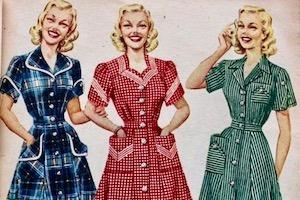In the Community
Do Women Still Do the Housework? AU Professor Kate Haulman curates Smithsonian exhibit on women and housework

Who does the cleaning in your house?
If you are a woman, and you do the bulk of the housework, you are not alone. And now there is a new Smithsonian exhibition for you — All Work, No Pay: A History of Women's Invisible Labor, guest-curated by Kate Haulman, associate professor in AU’s Department of History. The exhibit, which opened on March 4 at the National Museum of American History (NMAH), examines the historical role of housework with special attention to race and class, and how women continue to be responsible for most of the unpaid work at home despite their advances in the paid labor force.
Haulman curated the exhibition with Kathleen Franz, chair and curator of the NMAH’s Division of Work and Industry. Franz is also AU’s Distinguished Public Historian in Residence, as well as the former director of AU’s Public History Program.
The exhibit was timed to coincide with Women’s History Month and International Women’s Day.
The History of Housework
When Franz approached Haulman with the idea of doing an exhibit on women and work, they knew they wanted it to focus on something slightly different from the much-explored story of women’s entry into the paid workforce. Instead, they decided to focus on work done in the home, tasks like cleaning, cooking, and caring for family members. “This work is unpaid, enduring, and largely invisible,” says Haulman. To tell this story, she and Franz chose costumes and other artifacts from Colonial America to the 1990s including aprons, housedresses, electric irons — and even today's version of the housedress: yoga pants.
“In the exhibition, we use costume to make the invisible visible,” Haulman explains.
The exhibition explores the theme of unpaid domestic work in three sections. Separating Home and Work explores gender roles and changing ideas about work in early America. Making Unpaid into Paid Work contrasts some women’s gains in the paid workforce against unpaid work in the home from the 1890s to 1940s. And The Second Shift focuses on how women continue to be responsible for most housework, despite advances in the workforce and progress in women's rights from the 1960s through the 1990s.
The costumes and artifacts chosen for All Work, No Pay, Haulman says, illustrate the longstanding feminization of domestic work, set against complicated dynamics and inequalities of race and class among women. The exhibition also examines the value of women’s paid labor with an infographic featuring 2013 US Census data showing that women on average earn 80 cents to every dollar men make.
Inspiring Conversation about Work
All Work, No Pay is part of the Smithsonian American Women's History Initiative, #BecauseOfHerStory. The initiative is part of an ambitious undertaking to deepen understanding of women's contributions to the nation and the world.
Franz and Haulman designed the exhibit in a way that encourages intergenerational conversations about gender and labor. Visitors are invited to sit and share stories about who historically did the work in their homes. Curators will record and preserve oral histories for the museum's permanent collection.
Haulman says All Work, No Pay has elicited many stories about how work was done in people’s families. “We’re hoping to collect more oral histories from museum-goers,” she says. “Housework or memories of it form a part of almost everyone’s story. Mainly, we want people to see and understand it as work—historically unpaid or underpaid but essential and done mainly by women.”
